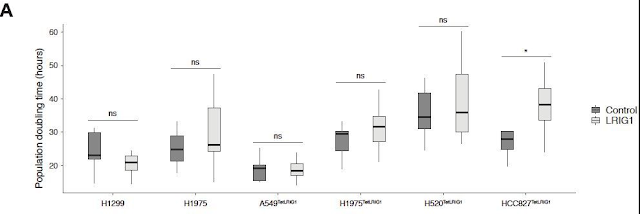Background. High levels of the leucine-rich repeats and immunoglobulin-like domains protein 1 (LRIG1) in tumor tissue are associated with a survival benefit in early-stage non–small cell lung cancer (NSCLC) due to presently unknown mechanisms.
Methods. A panel of NSCLC cell lines was transduced with LRIG1 expression vectors. Cell proliferation, chemosensitivity, radiosensitivity, clonogenicity, and migration were measured in vitro. Mice were implanted with mixed-cell populations, and the fraction of LRIG1-overexpressing cells was compared among metastatic sites, primary tumors, and injected cell populations.
Results. Clonogenicity was reduced in LRIG1-overexpressing cell lines. Minor or no changes were observed in the other analyzed functions. LRIG1 was neither enriched nor depleted in tumor cell populations at different metastatic sites.
Conclusion. LRIG1 reduced clonogenicity in vitro, but no other single underlying mechanism for LRIG1 tumor suppression in NSCLC was identified. Cell lines established from advanced NSCLC might not be a suitable model for mechanistic studies of early-stage disease.
Ur studien väljer jag som vanligt att enbart saxa ur HoloMonitorrelaterat.
Methods
Live-cell proliferation and migration assays
For all live-cell assays, cells were seeded at a density of 10,000 cells per cm² in either standard 6-well or Sarstedt Lumox 24-well plates. To induce LRIG1 expression in LRIG1-inducible cells, 1 µg/ml of doxycycline was added. Plates were incubated overnight. Prior to recording, wells were washed once in PBS to remove debris, resupplemented with standard cell culture medium, covered with HoloLids (Phase Holographic, Lund, Sweden), and inserted in a HoloMonitor holographic microscope (Phase Holographic) mounted inside a standard cell culture incubator. Live-cell imaging was performed on 16 predefined 0.52 × 0.52 mm areas per well, which were continuously recorded at 8-minute intervals for 48 hours. Proliferation curves were created by measuring the cell count in each area at 1-hour intervals, and doubling time was calculated by comparing cell counts at t = 0 and t = 48 hours. Cell migration, measured as average cell motility in µm/hour, was calculated by tracking individual cell movements on a frame by frame basis.
Figure 1. LRIG1 does not affect cell proliferation rates of most NSCLC cell lines.
(A) Proliferation rates of NSCLC cell lines without or with LRIG1 overexpression. Different NSCLC cell lines were transduced with a constitutive LRIG1 expression vector (H1299 and H1975) or an inducible LRIG1 expression vector (A549TetLRIG1, H1975TetLRIG1, H520TetLRIG1, and HCC827TetLRIG1). The inducible cell lines were either not treated (control) or treated with doxycycline (LRIG1) to induce LRIG1 expression. Cell proliferation was monitored via live-cell imaging using a Holomonitor M4 instrument. Shown are the calculated population doubling times, in hours, for the respective cell lines. For the doxycycline-inducible cell lines, data are shown both for untreated cells and doxycycline-treated cells. Shown are box plots; means are from 10 areas measured over 48 hours with 1 time point per hour, in 3 technical replicates and, for H1299 and H1975, 4 biological replicates. Significance is represented using * for p < 0.05.
Övrig data och slutsatser får ni själva läsa och ta del av.
Som jag likt en papegojja upprepar : Utrusta världens alla cancerforskare med varsitt HoloMonitorinstrument. På så sätt har vi bättre odds att möta denna best och förhoppningsvis vinna matchen.
Mvh the99

Inga kommentarer:
Skicka en kommentar